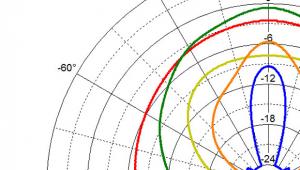Frequency Response: A Show and Tell Page 3
Bandwidth of the error
If a frequency response error affects a narrow band of audio, it won't be as noticeable as an error that affects a wide band of audio. That may seem like another obvious statement. But it's also true that a mild error that affects a broad band of audio tends to be more bothersome than a large error that affects a narrow band of audio.
Let's go to a different snippet from George Stass to demonstrate. The first 13-second snippet is the unprocessed music. Next is the same snippet with a 1/3-octave-wide, -12 dB cut centered at 2 kHz (figure 5). And last is the same snippet with a 2-octave-wide, -6 dB cut, also centered at 2 kHz (figure 6).
The 1/3-octave-wide cut is certainly noticeable. But the 2-octave-wide cut has a more dramatic effect, even though its magnitude is much smaller. The deep, narrow cut adds a subtle variation, but the broad, shallow cut really dulls the sound. This is why a sharp resonant peak or dip is often inaudible or barely audible - although it sure looks awful in a frequency response chart.
Headphones: A different set of rules
The rules for headphones are different than for speakers. A full explanation of why is way beyond the scope of this article, but the simple explanation is that a headphone bypasses all the acoustical effects of a room and transmits sound straight into your ears. Bottom line: The flat response that works so well for loudspeakers in a room doesn't work at all for headphones. Design a headphone for flat response and you'll get sound that's so bright and trebly you won't be able to stand it.
A typical good headphone has +3 to +6 dB of boost below about 500 Hz; a dip in the midrange from 500 Hz to 2 kHz; a boost of +3 to +6 dB in the upper midrange/lower treble from 2 to 8 kHz; and a rolled-off treble response above 8 kHz. (A great example is the Skullcandy Roc Nation Aviator, whose frequency response can be seen in figure 7.) These are broad, general rules, though. Based on the panel tests I've done of speakers and headphones, I've found that while a speaker that measures flat tends to win over practically any listener, reactions to headphones are far more varied.
We've only just begun
This article barely scratches the surface of the science of frequency response. Tomes such as The Loudspeaker Design Cookbook devote hundreds of pages to the subject, and there's also quite a bit of knowledge that resides only inside the minds of the world's finest speaker engineers. But this gives you a good start. And most of the speaker reviews in the print and online versions of S+V include frequency response measurements - so take a few of those, go to a dealer or a hi-fi show and hear the actual speaker, and you'll start to understand how the science of frequency response measurements correlates with the art of listening.





























































